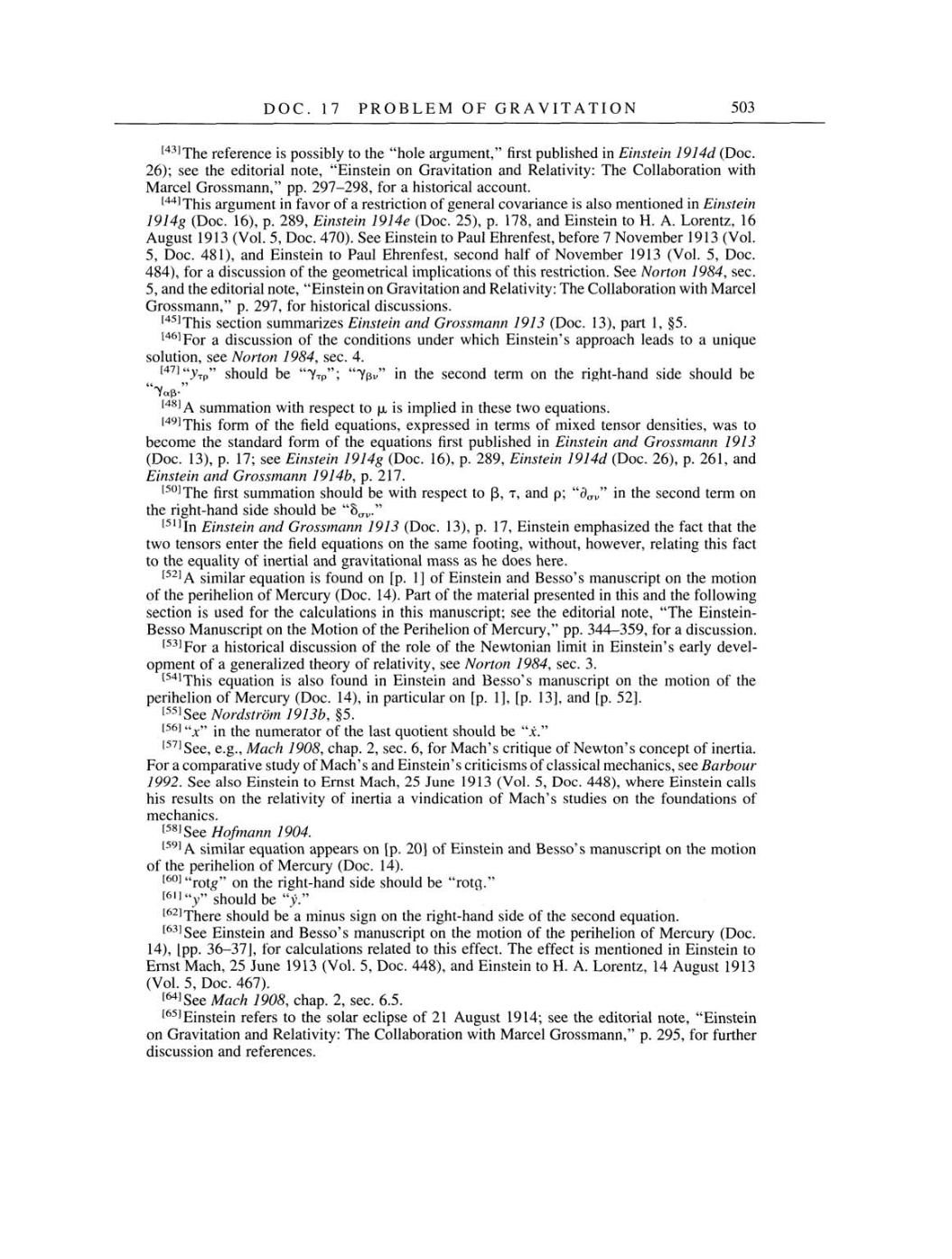DOC. 17
PROBLEM OF GRAVITATION
503
[43]The
reference
is possibly to
the "hole
argument,"
first
published
in
Einstein 1914d
(Doc.
26);
see
the
editorial
note,
"Einstein
on
Gravitation
and Relativity:
The
Collaboration with
Marcel
Grossmann,"
pp.
297-298,
for
a
historical
account.
[44]This
argument
in
favor of
a
restriction of
general
covariance
is
also mentioned
in
Einstein
1914g (Doc. 16), p.
289,
Einstein 1914e
(Doc.
25),
p.
178,
and
Einstein
to
H. A. Lorentz, 16
August
1913
(Vol. 5,
Doc.
470). See
Einstein
to
Paul
Ehrenfest,
before
7
November
1913
(Vol.
5,
Doc. 481),
and Einstein
to Paul Ehrenfest,
second half of November
1913
(Vol. 5,
Doc.
484),
for
a
discussion of the
geometrical implications
of this restriction. See Norton
1984,
sec.
5,
and
the editorial
note,
"Einstein
on
Gravitation and
Relativity:
The Collaboration
with
Marcel
Grossmann,"
p.
297,
for historical discussions.
[45]This
section summarizes Einstein and Grossmann
1913
(Doc. 13), part
1,
§5.
[46]For
a
discussion of the conditions under which Einstein's
approach
leads
to
a
unique
solution,
see
Norton
1984, sec.
4.
[47]"YtP"
should
be
"YtP"; "Yßv"
in
the second
term
on
the right-hand side
should
be
"Yaß".
[48]A
summation with
respect
to
u
is
implied
in
these
two
equations.
[49]This
form of the
field
equations, expressed
in terms
of mixed
tensor densities,
was
to
become
the
standard form of the
equations
first
published
in
Einstein and Grossmann
1913
(Doc. 13), p. 17; see
Einstein
1914g
(Doc. 16), p. 289,
Einstein 1914d
(Doc. 26),
p.
261,
and
Einstein and Grossmann
1914b,
p.
217.
[50]The first
summation should
be
with
respect
to
ß, t,
and
p;
"dav"
in
the second
term
on
the
right-hand
side should be
"8av."
[51]In
Einstein and Grossmann
1913
(Doc. 13), p.
17,
Einstein
emphasized
the fact that the
two tensors
enter
the
field
equations
on
the
same footing,
without,
however, relating this
fact
to
the
equality
of inertial
and gravitational
mass as
he
does
here.
[52]A
similar
equation
is
found
on [p.
1]
of
Einstein
and Besso's
manuscript on
the motion
of
the
perihelion
of
Mercury (Doc. 14).
Part of the material
presented
in
this and the
following
section
is
used for the calculations
in this manuscript;
see
the editorial
note,
"The Einstein-
Besso
Manuscript on
the
Motion of
the
Perihelion
of
Mercury,"
pp.
344-359,
for
a
discussion.
[53]For
a
historical discussion of the role of the Newtonian limit
in
Einstein's
early
devel-
opment
of
a
generalized theory
of
relativity, see
Norton
1984, sec.
3.
[54]This
equation
is also
found
in
Einstein
and
Besso's
manuscript
on
the
motion
of
the
perihelion
of
Mercury (Doc.
14),
in
particular
on
[p. 1],
[p. 13],
and
[p. 52].
[55]See
Nordström
1913b,
§5.
[56]"x" in
the numerator
of
the
last
quotient
should
be
"x."
[57]See, e.g.,
Mach
1908,
chap.
2, sec. 6,
for Mach's
critique
of Newton's
concept
of inertia.
For
a
comparative study
of Mach's
and
Einstein's criticisms of
classical mechanics,
see
Barbour
1992. See
also Einstein
to
Ernst
Mach, 25
June
1913
(Vol. 5,
Doc. 448),
where Einstein calls
his results
on
the
relativity
of
inertia
a
vindication of Mach's studies
on
the
foundations of
mechanics.
[58]See
Hofmann
1904.
[59]A similar
equation appears
on [p.
20]
of Einstein
and
Besso's
manuscript
on
the motion
of
the
perihelion
of
Mercury (Doc. 14).
[60]"rotg"
on
the
right-hand
side
should
be "rotg."
[61]"y"
should
be "y."
[62]There
should be
a
minus
sign on
the
right-hand side
of
the second
equation.
[63]See
Einstein and Besso's
manuscript
on
the
motion of
the
perihelion
of
Mercury
(Doc.
14),
[pp.
36-37],
for calculations related
to this
effect. The effect
is
mentioned
in
Einstein
to
Ernst
Mach, 25
June
1913
(Vol. 5,
Doc.
448),
and Einstein
to H. A. Lorentz,
14 August
1913
(Vol. 5,
Doc. 467).
[64]See
Mach
1908,
chap.
2, sec.
6.5.
[65]Einstein
refers
to
the solar
eclipse
of
21 August 1914; see
the editorial
note,
"Einstein
on
Gravitation and
Relativity:
The Collaboration with Marcel
Grossmann,"
p.
295,
for further
discussion
and
references.
